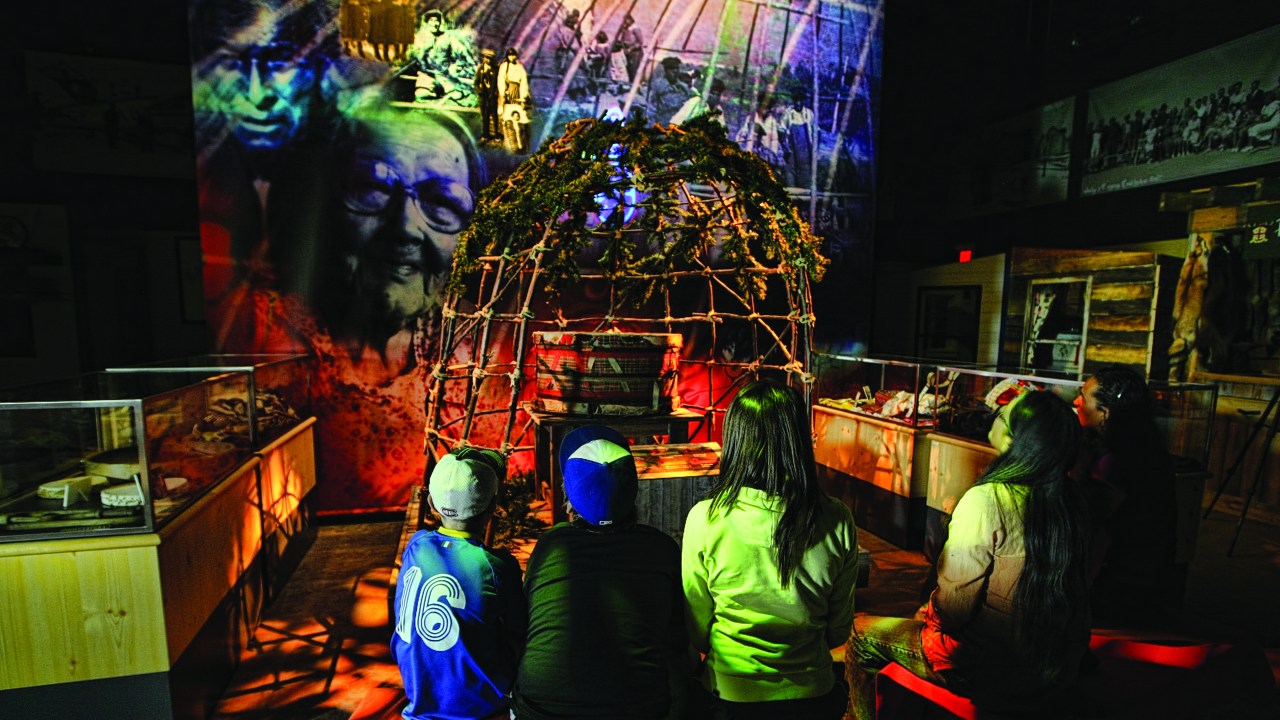
This article originally appeared in Museum magazine’s March/April 2023 issue, a benefit of AAM membership.
Science North’s recipe for success creating object theaters.
“That is our Kite-a-lite. Our link to the Fleece-net: a worldwide communications network of woolly ungulates, dedicated to battling climate change. Climate change: it’s here lamby, you can taste it in the grass!”
I still remember the first time I saw that giant kite object light up above the screen. It was introduced by Sheepy, the intelligent and sarcastic animated talking sheep–narrator in The Changing Climate Show object theater. It was my first week at my new job as an entry-level production assistant in the media production unit of Science North, Canada’s second-largest science center with a home base in Sudbury, Ontario. My onboarding included watching this and other shows to build my understanding of this new-to-me form of communication media.
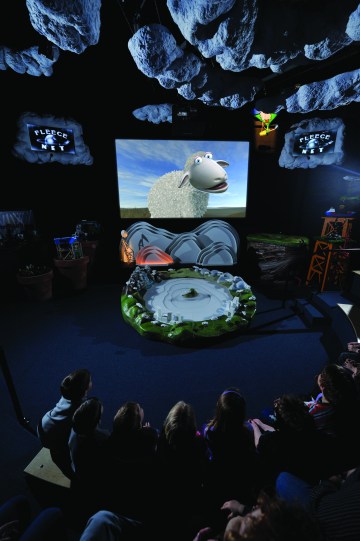
Object theaters move beyond a traditional film experience—though film, whether live-action or animated, is a central feature. Beyond the film element, visitors can expect to witness objects light up, move, and change forms; participate directly with their bodies; make choices to direct a personalized storyline through different technologies; and contribute their own science knowledge and data to the experience. At Science North, we have found that object theaters are one of the best ways to communicate complex themes to audiences.
By physically immersing audiences in the subject of the story using everyday language and points of reference, they can meaningfully connect to the material and increase understanding. Object theaters are a staple in our own two science centers, and our home-grown experience has allowed us to create custom productions for science centers, museums, and cultural attractions around the world.
Since that first experience with Sheepy, I have become a producer and senior editor at Science North, and I’ve spent the past 15 years creating numerous object theaters. From my tremendously experienced colleagues and audience research, I have learned the “secret sauce” that forms the base of all successful object theaters.
The Ingredients for Success
The first ingredient for success in object theaters is knowing your audience. What do they know? What do they want to know? What don’t they know? Science North works closely with project partners to better understand public knowledge of particular topics.
For example, while developing the Climate Action Show, we created several different versions of the show—one customized for our center and several others for institutions around the world. Teams from the Hong Kong Science Museum and Science Centre Singapore directed the creation of customized vignettes featuring local scientists and stories that would resonate with their audiences. For Science North’s newest show, the Big Impact theater, which is still under development, we are working with leaders in the mining sector to understand what people in Northern Ontario know about mineral sciences and the industry’s use of new green technologies. This show will run at Dynamic Earth, a Science North attraction focused on earth sciences and mining.
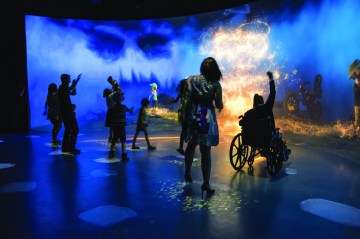
To help build the content of our object theaters, we ask our visitors to answer questionnaires, and we often ask them to participate in a focus group. We ask what they’d like to learn on the subject while also exploring vocabulary, ideas, assumptions, relationships, and background on the topic. This helps us start imagining the show concept, a process that can last from six months to two years depending on the complexity of the topic. Once an object theater opens, a comparative evaluation helps us determine if we achieved our established learning goals for the show.
The next ingredient for success is analogies. Instantly relatable, everyday analogies help audiences make sense of complex science topics within their own frame of reference and personal experiences. The analogies are points of reference with which the audience is already familiar, leading to deeper understanding and the ability to remember and continue making sense of the material beyond the show’s conclusion.
A prime example is the “fishing net” analogy for finding dark matter particles in Secrets from the Sun, a previous Science North–based object theater. The stage was set with a spotlight on a fishing net, and audiences were asked to imagine minnows swimming through the gaps in the net. The net is our dark matter detectors, and the minnows are dark matter particles, almost always passing undetected through the gaps but occasionally brushing against the net, alerting scientists to their presence.
In The Changing Climate Show, we used an analogy featuring “Feedbaäch,” the death-metal sheep band. As Sheepy yells, “Cue the band!” the sheep singers have their mics too close to the amplifiers. The sound coming out of the speakers is picked up by the mics, then amplified again, picked up by the mics again, and so on, louder and louder. A similar pattern happens with Earth’s climate. The Arctic Ocean is mostly covered by ice, but as the planet warms, there is less ice. This means there is less white surface, which reflects sunlight, and there is more open dark water, which absorbs sunlight. This absorption further heats the water, resulting in even less ice, which in turn means more dark water to absorb even more sunlight—a feedback loop.
The Take Over Control show at the Niagara Parks Power Station explores, among other things, the necessary synchronization of electrical power generation and getting that power onto the electrical grid. Here, the analogy is of a game of double-Dutch jump rope: you must first get your body in sync with the two moving ropes in order to successfully jump in.
Analogies are like the connective tissue of an object theater’s narrative. They work best when paired with other story elements, such as presenting different points of view or providing a mystery to solve or a quest to complete.
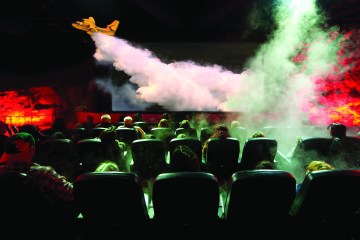
Last, but certainly not least, the third core ingredient of object theater is objects—including physical interactives and sensory experiences. These are all the other components beyond the screen that allow audiences to physically interact with the show’s content. To emphasize the increasingly severe weather patterns resulting from our changing climate, The Changing Climate Show featured wind, rain, and heat effects resulting in the audience physically experiencing these elements—in other words, they got wet!
In the BodyTrek Theater at the Denver Museum of Nature and Science, audience members engage with a live-action guide who is climbing nearby Mt. Evans and discovering the physiological effects of the hike on her body. As she climbs, the audience measures their own body functions, such as heart rate and blood oxygen level, using individual devices at each seat, giving them a personal connection to and understanding of the content.
In Ready, Set, Move! at Science North and Experimentarium in Hellerup, Denmark, body-sensing technology follows the physical actions of the audience to affect real-time outcomes in the animated content. When the main character Anna is navigating a flooded river, the audience is encouraged to act as a group and use their body movements to steer her raft safely around objects. Physical movement is part of the story and helps impart a message of active living to audience members. These tangible elements allow audiences to connect with the content in a way unique to object theater.
A strong lead character is the added seasoning that allows audiences to fully embrace the information being communicated. Simply put: shows with a strong character work very well, and those without do not. We’ve learned this through trial and error over the years.
For example, in Club Genome, a Science North object theater about human genetics, we knew our audience and their knowledge level. We employed a robust analogy between music-making and DNA sequencing throughout the show. However, we chose not to use a lead custom character, instead using an authoritative, omniscient narrator. Feedback from that show made clear that while the analogy was mostly understood, audiences never felt fully drawn into the show and thus were not able to fully connect with the content and form their own deeper understanding. Through summative evaluation and informal conversations with staff and visitors, we concluded that the lack of a relatable character was the principal reason for this missed connection.
This is in notable contrast to shows that feature a strong lead character that have become audience favorites. For example, when Sheepy first appeared in The Climate Change Show, he was instantly beloved by audiences. The connection was so profound that not only did Sheepy become the focal point for our now-completed trilogy of climate-focused object theaters, he also became the call-to-action for green and sustainable practices at Science North and on our social media platforms. Characters bring audiences fully into the story and make complicated topics fun and relatable in a way neutral narration cannot match.
A Team Effort
Mixing together all the ingredients of great object theaters are the chefs—the project team. Every object theater team is made up of specialists in science communication, multimedia, and technology. They are then joined by topic experts, industry partners, and clients. This team works together to provide insight on the audience’s knowledge level; determine what objects, effects, and analogies will lead to greater understanding of the subject matter; and create a character that will draw the audience in, allowing them to fully connect with the content. Each team member, regardless of their area of specialty, contributes to the conversations on content, story, and technological approaches.
The whole process is incredibly fluid: a new insight about audience will signal a piece of content to highlight, which will initiate brainstorming about what analogy to use, which will lead to the addition of a new object, resulting in research on different multimedia technologies, which often means a totally new direction for the story. This iterative process occurs throughout the show’s development.
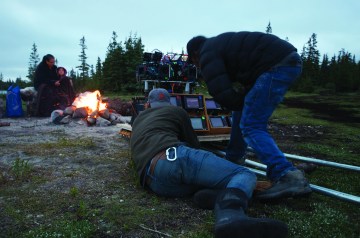
While the “secret sauce” of object theaters provides the base recipe upon which to build a final dish, each new show involves a unique combination of ingredients. Currently, we are embarking on the concept plan for an object theater to play at a future site in Thunder Bay, Ontario. Relying extensively on community input and information gathering, that team will feature a deep collaboration with Indigenous knowledge keepers and creators to center Indigenous science and ways of knowing. We are not experts in this subject matter, and are deeply grateful and humbled by the generosity of the knowledge keepers and community members working as true partners with us in the creation of this new experience.
I have consistently seen object theaters help audiences understand complex information in ways that are engaging, fun, and meaningful. Building this genuine connection between the audience and the world around them is the most joyous part of our work at Science North.







